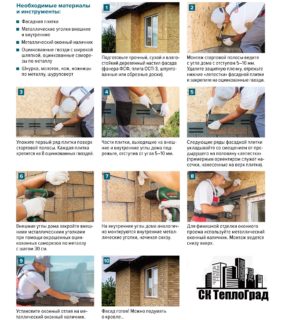Modern facade tiles are made from different materials with different characteristics. Facade tiles of different shape, color and texture are chosen depending on specific conditions.
Main characteristics of facade tiles
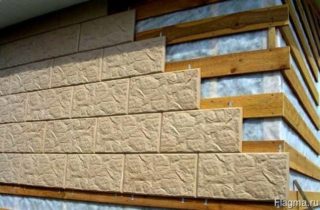
Products are produced so that they show effective working qualities in operation. The strength of the tiles is needed to withstand shock and wind forces.
The standard characteristics of facade materials include:
- wear resistance;
- moisture resistance;
- resistance to atmospheric factors;
- beautiful view;
- fire resistance.
Durability means resistance to damage from solar radiation. The products do not conduct or accumulate moisture, otherwise the first frost will lead to cracking of the face layer. Due to dampness, mold appears on the coating, fungi develop, therefore low hygroscopicity is important.
The atmosphere contains acids, alkalis, which destroy the tiles, therefore special additives increase the resistance. Facade decoration should not burn when the fire spreads; under normal conditions, its appearance should be attractive.
Application area
Finishing tiles for outdoor use are often used indoors, where they look organically on the walls and ceiling. Facade units made of natural material look on the basement of buildings and are combined with landscape elements in the form of reservoirs, pools, thick tree trunks. Brick tile has good durability and benefits in terms of cost.
The facing tiles for the facade of the house are used for outdoor decoration, they are available for sale in different colors and textures. The wealth of choice allows the use of clinker slabs in the combined design of high facades, the products do not load the foundation, since they are lightweight.
Porcelain stoneware is used in the exterior of houses with small entrances, basements of cafes and shops. Ceramic products are cheaper than clinker and porcelain stoneware, have a significant weight, are used on the facades of mansions, private houses, sometimes in combination with decorative plaster.
Varieties of facade tiles
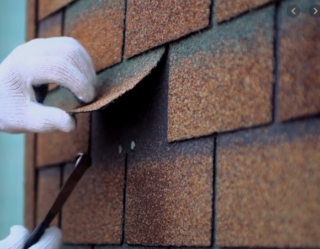
The quality of the finishing material and its price depend on the base base and initial raw materials. Products made from natural ingredients do not deteriorate for a long time, have a beautiful appearance, high cost, for example, granite, marble. They are replaced by tiles obtained by a synthetic method, for example, aerated concrete tiles for facade decoration, which almost do not differ in quality.
Varieties of products:
- soft bituminous;
- coated metal siding;
- vinyl panels;
- clinker tiles;
- thermal panels;
- porcelain stoneware.
They use imitation of natural materials, make tiles from agglomerates (clay, spar, quartz, mica). The composition contains resins, ingredients obtained from plasma and vacuum technologies. Artificial surfaces convey the texture of natural wood, stone, they are produced matte, glossy, with an uneven surface.
Flexible bituminous
Fiberglass in the manufacturing process is impregnated with bituminous mastics with appropriate additives, and the surface is sprinkled with granulated basalt crumbs.
The composition of the material is similar to bituminous shingles and almost completely repeats its properties:
- ease of application;
- resistant to ultraviolet light;
- moisture resistance;
- frost resistance.
Due to its small dimensions, the consumption of facade tiles corresponds to the squaring of the surface to be finished, there is no overrun for cutting. The tiles are glued on special compounds that harden quickly. The material does not accumulate moisture, dampness does not develop, microorganisms do not live on the surface. Flexible bitumen boards do not fade from the sun, because components for special protection are added during production.
Metal siding
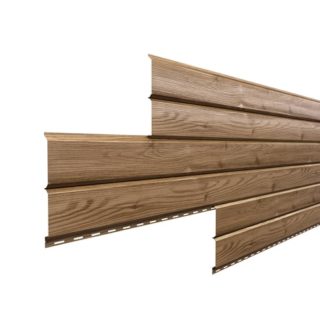
The material is used as a tile for facing the facade of large commercial buildings; in private housing construction, such elements are rarely used. The products are obtained by rolling zinc plating (0.35 - 0.65 mm) with a polymer layer applied to both sides for protection. Sometimes aluminum strips are taken as a basis.
The surface is corrugated or smooth, the elements are rectangular or square, the ends of the panels are equipped with grooves for overlapping. Facade finishing made of metal siding does not deteriorate at a temperature of +50 - -80 ° C, from the action of exhaust gases and mechanical shock.
Products are mounted on a metal frame, therefore, they form a ventilated type of facade. Insulation and waterproofing are placed inside the frame.
The disadvantage of metal siding is that the finishing layer heats up in winter and cools in summer, which affects the temperature of vertical fences.
Vinyl

The cladding is made of PVC base, in the composition of the plastic tiles up to 80%. The rest of the volume is occupied by plasticizers, modifying additives, dyes. Vinyl tiles belong to the budget types of cladding, but they have a beautiful look. The material imitates natural stone, different types of wood, braid, fabric. The surface is produced textured or smooth.
Each element is equipped with a clip-lock for attaching to an adjacent product. Lightweight boards do not create a load on the walls, resist moisture, do not fade in the sun. For installation, a frame made of steel profiles is required, which is combined with external insulation. As a result, the walls of brick, concrete do not need to be leveled, since the tiles hide all the irregularities. The disadvantages of plastic facade tiles include resizing in heat and cold.
Clinker brick
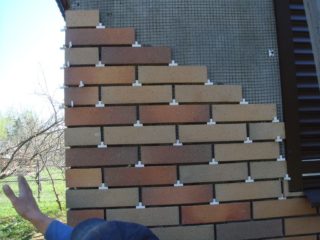
Produced from refractory grades of shale clay, in which there are no salts and calcium carbonate. Plasticizers, unnatural coloring components are not used in production, therefore the material is classified as environmentally friendly materials.
The products are distinguished by a large assortment of textures and colors. It is used for cladding the facades of buildings in industrial, commercial and private construction. Clinker boards look like red bricks on the walls.
The material is characterized by minimal moisture absorption, the volume of which is no more than 3% by weight. As a result, frost and thawing periods do not affect the integrity of the products.
Thermal panels
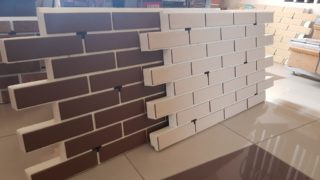
The material is environmentally friendly, does not have a harmful effect on the surrounding space. Plates consist of a front layer made of different materials and insulation in the form of extruded polystyrene foam or polyurethane foam. On the decorative side, porcelain stoneware, clinker, glazed ceramics, and unnatural stone are used.
Multifunctional panels have the following properties:
- products are used on any surfaces;
- installation is carried out in different weather;
- slabs decorate and retain heat at the same time;
- have resistance to weathering and durability;
- do not rot, do not decompose.
The dimensions of the thermal panels are accurate, so there are no errors during installation, lightweight material does not require an additional base. One square layer weighs about 15 kg.
Porcelain stoneware
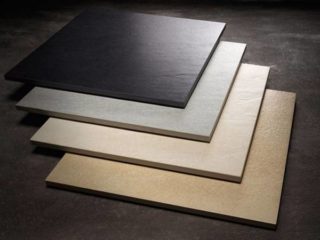
They are made from granite groats, expanded clay with the addition of dyes and mineral modifiers. The appearance resembles natural stone, but weighs less and has an acceptable cost. Produced by firing in frying chambers at 1200 - 1300 ° C. As a result, the material becomes frost-resistant and gains strength. Samples can absorb up to 0.05% moisture based on total weight.
Products with a smooth, polished, satin finish are produced. A polished look is put on the facade, which looks beautiful, sometimes a matte variety is used. The thickness is 7 - 25 mm, its choice depends on the bearing capacity of the wall and the base of the house. Section sizes vary from 10 x 10 to 60 x 60 cm.
Features of choice
Other factors to consider when choosing:
- compliance with the design project, combination with the material of the roof, window frames and door leaves;
- features of the installation technology;
- whether preparation of surfaces is required for installation.
The frame is installed according to the assembly technology, sometimes it is necessary to level the area of the facade with wet solutions for stickers, for example, porcelain stoneware. Such works take time to dry, which I also take into account when choosing.
DIY styling rules
Some craftsmen glue tiles directly to the surface of the facade, if the geometric parameters allow this. But it is better to prepare and fix the rack frame or steel mesh on the outer walls. The elements are laid first from the bottom, gradually rising. The adhesive mixture is applied with a notched trowel simultaneously to the surface and the finishing unit.
The range of tiles includes corner elements, adapters for window and door slopes, and parts for installing basement eaves. If there are none, carefully cut the tiles with a grinder (circle 115 mm) exactly to size. The laying plane is regularly checked with a horizontal and vertical level. After joining, the seams are rubbed with a special compound to decorate and protect against moisture.

